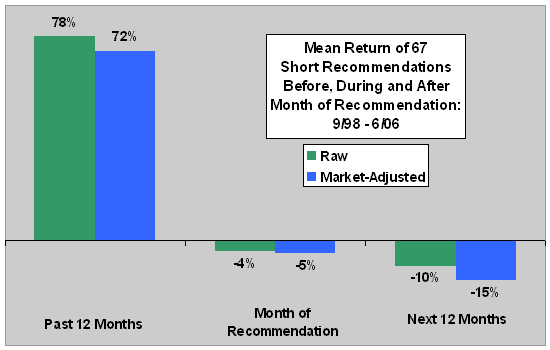Can analysis of firm financial data reliably identify future underperformers? Reader Mike Long of Short ALERT suggested for review a “paper that reverse engineers the short recommendations of an independent research firm into a model for selecting good short candidates” (disclosing that the research firm is Short ALERT). In the April 2007 draft of their paper entitled “The Role of Fundamental Analysis in Information Arbitrage: Evidence from Short Seller Recommendations”, Hemang Desai, Srinivasan Krishnamurthy and Kumar Venkataraman investigate whether analysis of company financial data reveals good shorting candidates. They first create a model of shorting demand by correlating company financial data for 1997-2004 with 54 valuation-motivated short sale recommendations from 67 reports issued by an independent research firm during 1998-2005. They then test the model out-of-sample (1990-1996) for a larger set of companies. Using the 67 reports, company financial data for 1990-2004 and monthly stock return data for 1990-2006, they conclude that:
- The stocks identified in the 67 reports, encompassing 23 industries, have a mean raw (market-adjusted) return of -4.0% (-4.9%) for the month in which the report is issued and -9.7% (-15%) during the next 12 months. (See the chart below.) These companies have an unusually large number of negative news events during the next 12 months, such as earnings shortfalls, reduced guidance for future earnings/sales and analyst downgrades.
- These reports indicate that valuation-motivated short sellers tend to target companies with:
- High accruals with large increases in sales, selling, general and administrative expenses and gross profit margin (suggesting unsustainability);
- Low book-to-market ratios and high one-year past returns (suggesting exuberance that may quickly revert); and,
- Liquid securities (minimizing risk of short squeezes).
- A model that incorporates these observations successfully predicts both short interest and future returns for an out-of-sample period. The 10% of stocks least (most) likely to be valuation-based shorting targets generates an economically large and statistically significant average monthly risk-adjusted return of 1.3% (-0.8%).
- In contrast, the model associates arbitrage shorting targets with high book-to-market ratios, existence of convertible bonds and inclusion in the S&P 500 index. Such stocks do not on average produce a statistically significant abnormal return.
- Findings are robust to alternative accrual measures and to industry effects.
The following chart, constructed from data in the paper, summarizes the mean performance of the companies identified in the 67 reports used in this study during the year before, the month of, and the year after report issuance. Results suggest that the method used in the reports successfully “calls tops” for overachieving stocks. The study analyzes the fundamentals of these firms to infer critical valuation-based shorting criteria.

In summary, fundamental analysis (especially accrual-related indication of poor earnings quality) helps valuation-motivated short sellers identify stocks likely to experience reversal of strong past returns.
It would be interesting to compare raw and market-adjusted performance of the stocks from the 67 reports, and those selected by the model, during bull and bear markets as a further test of the reliability (and practical use) of the methodology.